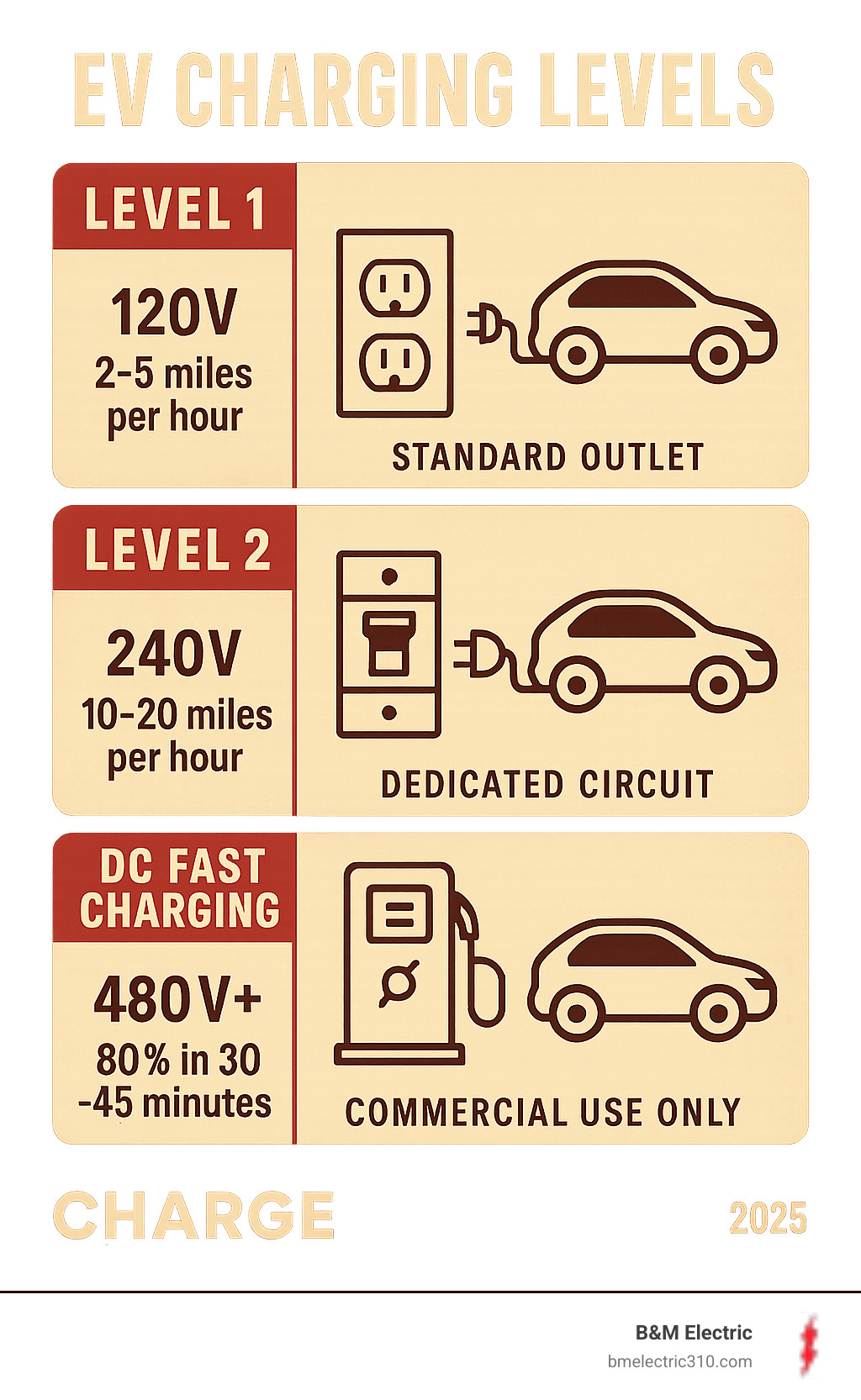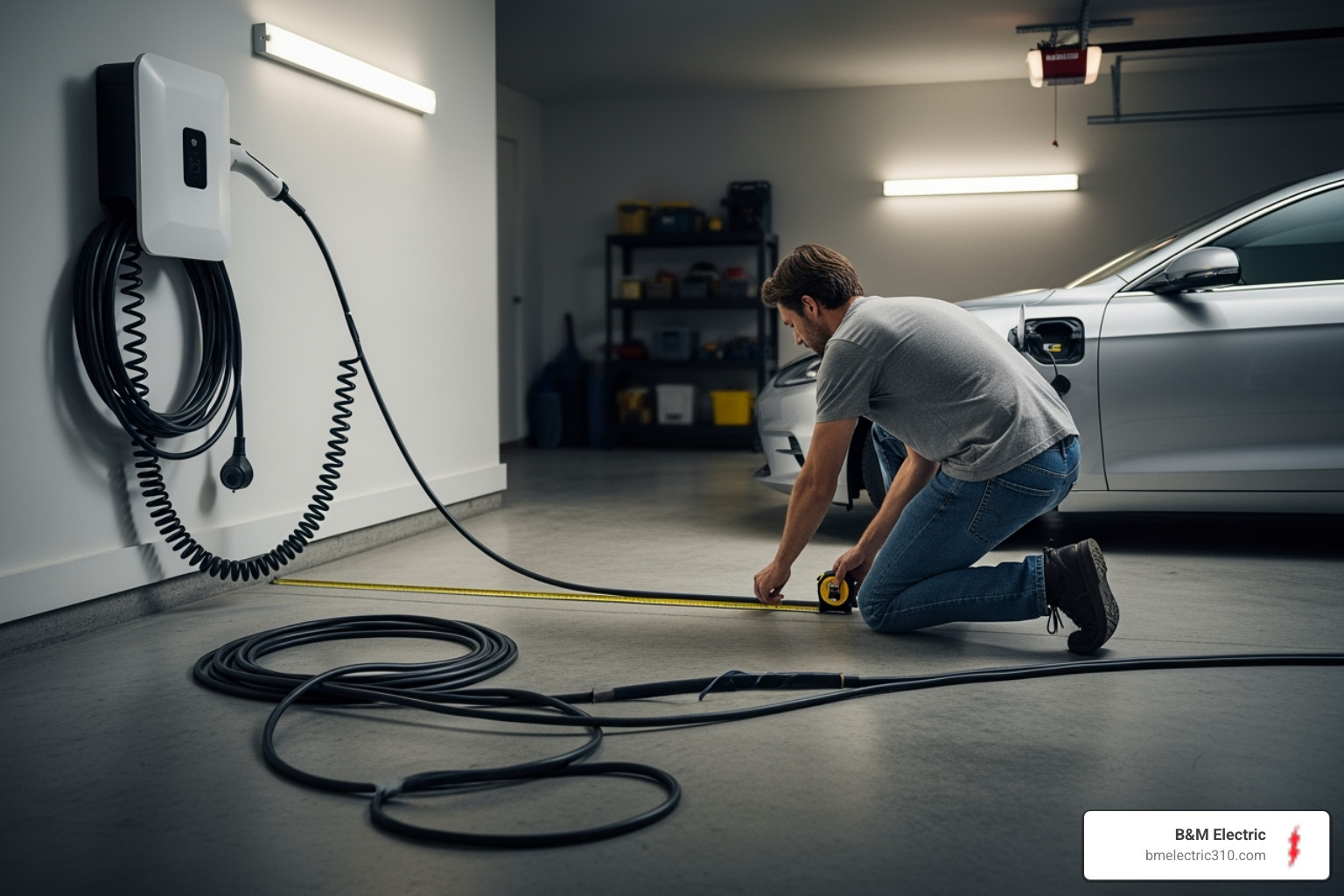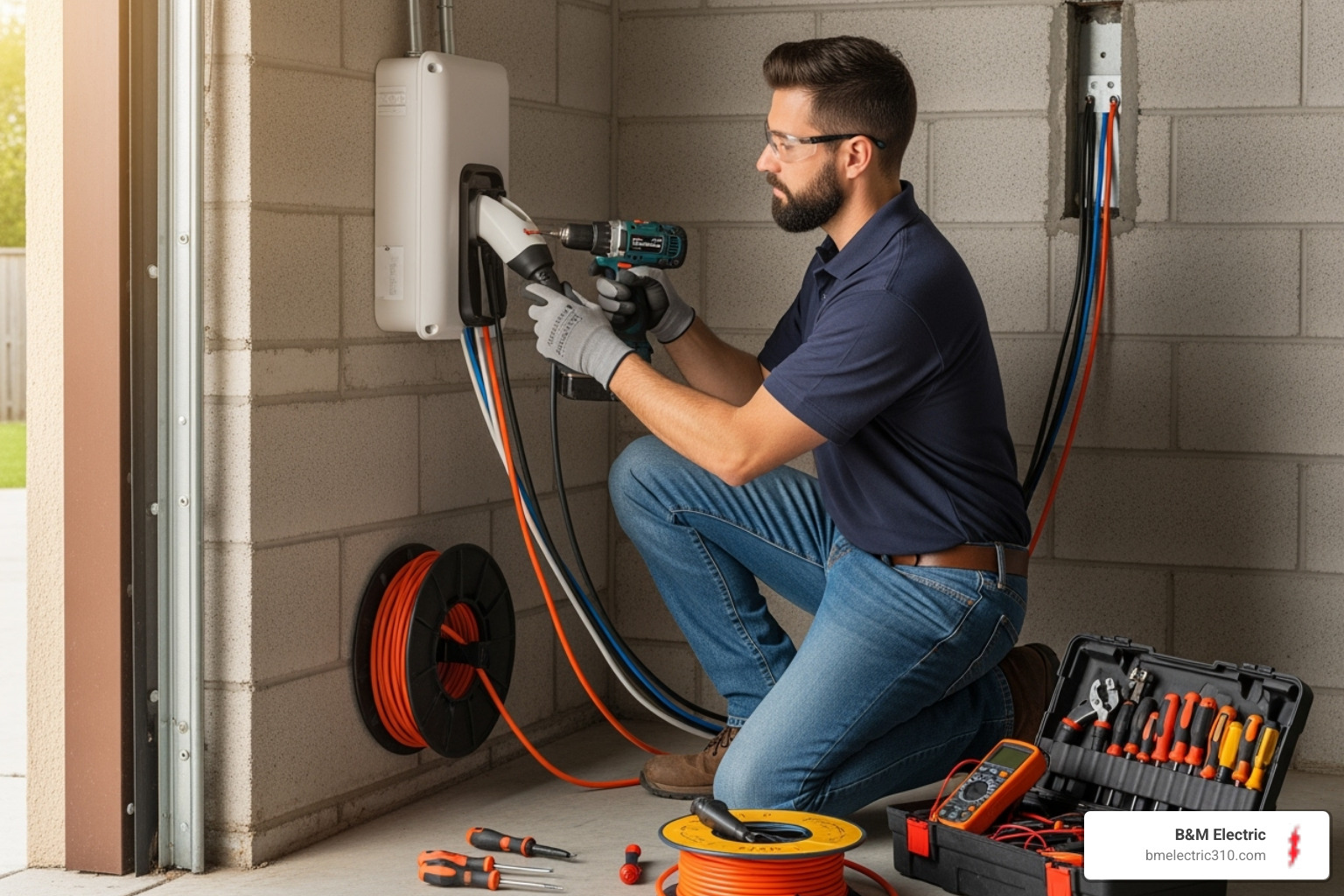Amp Up Your Ride: Installing an EV Charger in Your Garage
By B&M ElectricSeptember 23, 2025
Garage EV charger install: Ultimate Safe 2025
Why Home EV Charging is a Game-Changer
Garage EV charger install has become one of the most requested electrical upgrades as electric vehicles surge in popularity. With over 1.4 million battery electric cars now on the road, more homeowners are finding the convenience of charging at home instead of hunting for public charging stations.
Quick Answer for Garage EV Charger Install:
- Level 2 chargers (240V) are recommended for garage installation
- Dedicated circuit required – typically 40-60 amp
- Professional installation needed for safety and code compliance
- Mounting height should be 42-48 inches from floor
- Cable reach of 16-20 feet covers most garage layouts
- Permits and inspection required in most areas
Home charging offers incredible convenience – simply plug in when you get home and wake up to a fully charged vehicle. No more waiting at public chargers or planning trips around charging stops.
Level 2 chargers provide 10-20 miles of range per hour compared to just 2-5 miles per hour with standard wall outlets. This means overnight charging easily handles most daily driving needs.
The garage provides the perfect protected environment for your charging setup. It keeps equipment safe from weather while giving you easy access to your vehicle’s charging port.

Pre-Installation Planning: Gearing Up for Your Charger
Before any tools come out, you need to make key decisions about your garage EV charger install. Getting these fundamentals right from the start will save you headaches and ensure your charging setup perfectly fits your needs.
Choosing Your Charger: Level 1 vs. Level 2
The first big decision is choosing between Level 1 and Level 2 charging.
Level 1 chargers plug into any standard 120V outlet. While convenient, they are very slow, providing only 2-5 miles of range per hour. If you drive 40 miles daily, you’d need 8-20 hours to recharge. This makes Level 1 best for plug-in hybrids with smaller batteries or for drivers with very low mileage.
Level 2 chargers are where home charging shines. Operating on a 240V circuit (like an electric dryer), they deliver 10-20 miles of range per hour. This means overnight charging easily handles daily driving needs, so you wake up to a full charge. Most EV owners find Level 2 offers the perfect balance of speed and convenience, and the Benefits of Home EV Charging are most apparent with this setup.
You might hear about Level 3 or DC Fast Charging, but these are for commercial use at highway charging stations and require industrial-level electrical infrastructure.
Assessing Your Home’s Electrical Capacity
A Level 2 charger needs its own dedicated 240-volt circuit to ensure it doesn’t share power with other appliances. The challenge is that many homes, especially older ones, may not have enough spare electrical panel capacity. A typical Level 2 charger needs a 50-amp circuit for safety.
If your home has 200-amp service, you’re usually in good shape. However, homes with older 100-amp panels often need upgrades. A professional load calculation is required to determine if your panel can handle the extra demand. This assessment is not a DIY project, as overloading your system can cause tripped breakers or electrical fires. That’s why Electrical Panel Upgrades might be necessary for a safe garage EV charger install.
Plug-In vs. Hardwired: Which Installation is Right for You?
Your final decision is whether to choose a plug-in or hardwired installation.
| Feature | Plug-In EV Charger | Hardwired EV Charger |
|---|---|---|
| Power Output | Typically up to 40 amps | Can exceed 40 amps for faster charging |
| Portability | Take it with you when you move | Stays with the house permanently |
| Installation Complexity | Requires NEMA 14-50 outlet installation | Direct electrical connection |
| Weather Resistance | Depends on outlet rating | Generally more weatherproof |
Plug-in chargers connect to a NEMA 14-50 outlet. Their biggest advantage is portability; if you move, you can take the charger with you. They are also easier to replace.
Hardwired chargers connect directly to your electrical system. They often support higher power potential for faster charging and offer better weatherproof protection, but they are a permanent installation.
If you might move, plug-in offers flexibility. For a permanent home where you want maximum charging speed, hardwired is often the better choice. For more insights, check out our guide on Car Charger Installation Considerations.
The Ultimate Guide to Your Garage EV Charger Install
Now that planning is complete, it’s time for the actual garage EV charger install. This is not a DIY project. Working with 240V circuits requires a certified electrician for safety and code compliance. This guide provides a behind-the-scenes look at what our professional electricians do to transform your garage into an EV charging station, helping you make informed decisions.
Step 1: Selecting the Perfect Location
Choosing where to mount your EV charger is a strategic decision. Our electricians consider several key factors to optimize your daily charging experience.

- Your vehicle’s charge port location: The port’s location (front, side, or rear) and how you typically park are the starting points for determining the best charger placement.
- Cable length considerations: Most Level 2 charging cables are 16-20 feet long. This distance can be used up quickly depending on mounting height, parking angle, and the cable’s route around your car.
- Proximity to your electrical panel: The shorter the distance for new wiring, the simpler and more cost-effective your garage EV charger install becomes. Our electricians find the best spot for both convenience and electrical efficiency.
- Your parking habits: Whether you park nose-in or back-in affects where the charger should go. For multiple EVs, we might recommend a central location or dual-port options.
- Avoiding obstructions: We account for obstructions like opening car doors, storage, and workbenches to ensure the charger is safe, accessible, and not a hazard.
For detailed insights on optimal placement, our guide on Where to Install a Car Charger in Your Garage covers all the nuances we consider.
Step 2: The Electrical Work for a Garage EV charger install
This is where you need a Residential Electrician. The electrical work for a Level 2 EV charger is complex and potentially dangerous if not handled by a professional.
- Running new wiring: Your charger needs a dedicated circuit, which means running new, heavy-gauge wire (e.g., 8-gauge for a 40-amp charger) from your main electrical panel to the garage location.
- Installing a dedicated circuit breaker: This breaker is sized for your charger and is a critical safety feature that protects your home and investment by instantly shutting off power if anything goes wrong.
- Outlet or Junction Box: For plug-in chargers, we install a NEMA 14-50 outlet. For hardwired units, we create a dedicated junction box. Both require precision and adherence to electrical codes.
- Permitting and inspections: We handle all paperwork and coordinate required inspections. This ensures your garage EV charger install meets all local electrical codes and safety standards, guaranteeing the work was done right.
For homes with detached garages, the electrical work can be more involved, underscoring why professional expertise is essential.
Step 3: Mounting and Connecting the Charger
With the electrical infrastructure in place, we mount your new EV charger. This final step requires the same attention to detail as the previous ones.

- Mounting height: We typically install chargers between 42 and 48 inches from the floor—high enough to be safe from damage but low enough for easy daily use.
- Securing to a wall stud: We anchor the unit to a solid wall stud to handle the daily use and weight of the charging cable.
- Connecting to power: We connect the charger to the new NEMA 14-50 outlet or junction box, ensuring every connection is precise and insulated to code.
- Final testing: We verify voltage, check grounding, and run a test charge with your vehicle to ensure everything works perfectly. We only consider the job complete when we are satisfied with the performance and safety.
Our meticulous approach ensures your new charging station is functional, safe, and well-integrated into your garage. For more insights, check out our EV Charger Installation Essentials.
Post-Installation: Safety, Smarts, and Upkeep
With your garage EV charger install complete, adopting a few best practices will ensure it operates safely and efficiently for years to come.
Essential Safety Precautions for Your Garage EV charger install
Safety is paramount with your EV charger. Follow these precautions for peace of mind:
- Certified Equipment: Ensure your charger is safety certified by a lab like UL.
- GFCI Protection: Your charger circuit should have Ground Fault Circuit Interrupter (GFCI) protection to prevent electrical shock.
- Regular Cable Inspection: Visually inspect your charging cable before each use for wear, fraying, or cracks. Never use a damaged cable.
- Proper Ventilation: Ensure good airflow in your garage and keep the area around the charger clear of clutter and flammable materials.
- Avoid Extension Cords: Never use an extension cord with your EV charger. They can overheat and cause a fire hazard.
- Keep it Dry: Ensure the charging port and plug are dry before connecting.
- Emergency Preparedness: Keep a Class C fire extinguisher (for electrical fires) in your garage.
For more comprehensive guidance, review our Electrical Safety Tips.
Opening up the Power of ‘Smart’ Chargers
A ‘smart’ EV charger, which we highly recommend, offers significant convenience and savings. It integrates with your home Wi-Fi, allowing you to control and monitor charging from your smartphone.
Key benefits include:
- Mobile App Integration: Use a dedicated app as your command center to start or stop charging remotely.
- Scheduled Charging: This is a huge money-saver. Many utilities offer lower rates during off-peak hours. Smart chargers let you schedule charging for these times, significantly reducing your electricity bill.
- Energy Usage Tracking: The app provides detailed insights into your charging history and energy consumption.
- Remote Monitoring: Get real-time status updates on your charging session.
- Integration with Home Systems: Some chargers integrate with smart home ecosystems like Amazon Alexa.
Embracing a smart charger is all about Maximizing Efficiency Charging Your EV.
Taming the Tangle: Effective Cable Management
After your garage EV charger install, the charging cable can become a tripping hazard. Effective cable management is key to keeping your garage safe and organized.
Popular solutions include:
- Cable Holsters: Many chargers include a holster to store the connector, keeping it protected and off the floor.
- Wall Hooks: Simple, sturdy hooks provide a convenient place to coil and hang the cable.
- Retractable Reels: A retractable reel automatically winds up the cable, keeping it completely out of the way.
The golden rule is to keep the charging cable off the garage floor. This prevents tripping, protects the cable from damage, and keeps it clean.
Frequently Asked Questions about Garage Charging
Here are answers to the most common questions we receive about garage EV charger install projects.
How does a home EV charger affect my property’s resale value?
An installed Level 2 charger is a significant upgrade that can boost your home’s appeal to future buyers. As more people switch to EVs, having a charger ready is a major selling point that signals a modern, future-ready home. For buyers with an EV, your home instantly jumps to the top of their list. This improvement offers daily convenience now and pays dividends at resale. Homes with EV charging stand out in today’s market. Learn more about the impact of electrical upgrades on home resale.
Can I get rebates for installing an EV charger?
Absolutely! A surprising amount of financial help is available to offset the cost of your garage EV charger install. Federal, state, and local programs offer rebates, tax credits, and grants to support EV adoption. These incentives vary by location, and some utility companies have their own programs. What’s available in Torrance may differ from other areas. We recommend researching what’s available in your area so you don’t leave money on the table. You can view U.S. incentives to see which programs might apply to you.
What are the considerations for a multi-car garage?
For multi-car garages, there are several smart approaches to handle multiple vehicles. A professional can help you find the best solution for your family.
- Single charger with strategic placement: A single charger with a long cable, placed centrally, can often reach both parking spots. This allows you to charge one car at a time, which works well for many families who can alternate charging overnight.
- Dual-port chargers: These units charge two vehicles simultaneously from a single station, which is great if both cars need regular charging.
- Multiple individual chargers: This gives each vehicle its own dedicated station but requires a careful assessment of your home’s electrical capacity.
- Smart chargers with load management: These units intelligently distribute power between vehicles, preventing electrical overloads while keeping both cars ready to go.
A professional can evaluate your parking habits, electrical capacity, and driving patterns to design the perfect garage EV charger install solution for your vehicles.
Your Fully Charged Future Awaits
Installing an EV charger in your garage is a game-changer. Imagine never planning your day around a public charging station again. Instead, you pull into your garage, plug in, and wake up to a fully charged vehicle. It’s like having a personal gas station at home.
The convenience of a garage EV charger install is one of the smartest upgrades for an EV owner. You gain control over your charging schedule, can use off-peak electricity rates, and eliminate range anxiety.
However, while understanding the process is valuable, the complexity and safety risks of electrical work make professional installation non-negotiable. This involves running 240-volt circuits, ensuring proper grounding, and meeting codes. A mistake can lead to electrical fires, system damage, or injury. The peace of mind from a professional installation is invaluable; it ensures safety, code compliance, and protects your warranties and home insurance.
For homeowners in the Torrance area, the experienced team at B&M Electric brings five decades of local expertise to every installation. We seamlessly integrate this modern technology into your daily routine while upholding the highest safety standards. Our approach combines technical precision with customer care, handling everything from assessment and permits to final testing.
Ready to wake up to a fully charged vehicle every day? Schedule your EV charger installation in Torrance, CA today and take the first step toward energy independence in your own garage.